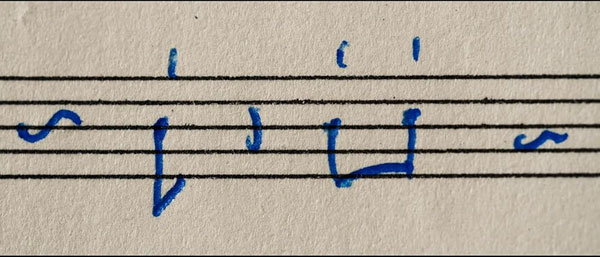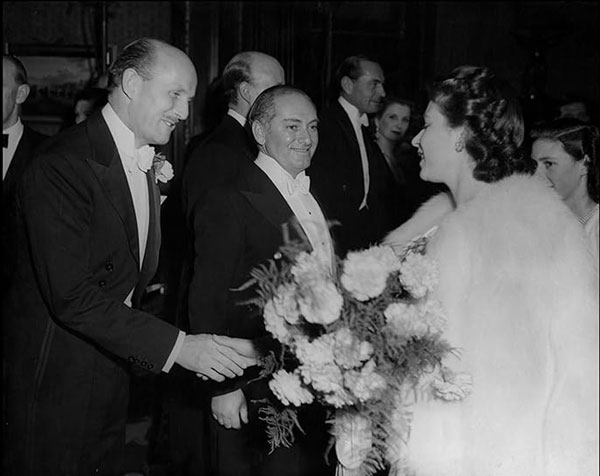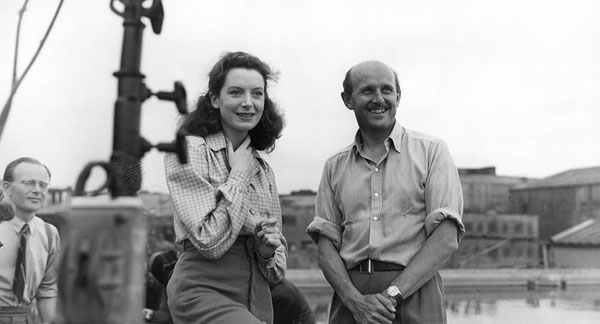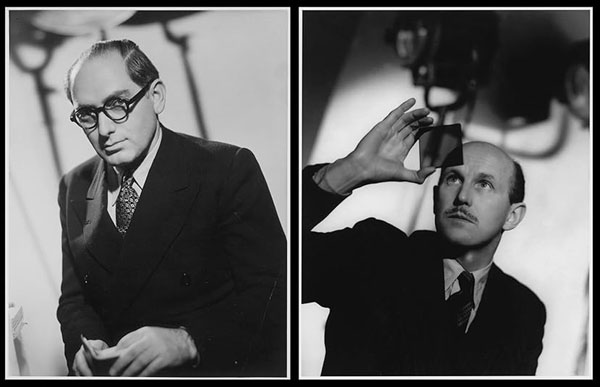|
Two new documentaries begin with old Italian men.
Martin Scorsese,
narrator and executive
producer of David
Hinton's Made in England: The Films of Powell and Pressburger, looks
directly into the
camera as he tells how
his childhood was
marred by
asthma. Young
Marty was forced to lie
in bed day after day,
his only company the
family's
black-and-white
TV. In those
infant days of
television, Scorsese
says, almost the only
programming was old
movies,
and—because U.S.
distributors were
nervous about letting
TV stations air their
movies—most of
the movies were
British. He loved those
films, especially the
ones that began with
the logo of an arrow
hitting a bullseye,
followed by the legend,
"A Production of the
Archers." That
meant he was in for a
dose of the very
special magic worked by
the
writing-directing-producing
duo of Michael Powell
(1905-1990) and Emeric
Pressburger (1902-1988).
Conversely, Guiseppe Tornatore's Ennio begins
wordlessly. An
old man lies on the
floor of his luxurious
living room to do his
morning
exercises. Then he
gets up, sits at his
desk, and starts
writing notes on music
staves. This is
Ennio Morricone
(1928-2020), composer
of scores for more than
400 films ranging from The Battle of Algiers to A Fistful of Dollars to Tornatore's own Cinema Paradiso.
Made in England and Ennio pay
tribute to three of the
most innovative,
visionary talents the
cinema has ever
seen. What is
extraordinary about a
film by Michael Powell
and Emeric Pressburger
is what is
extraordinary about a
score by Ennio
Morricone: a heightened
sense of possibility, a
constant element of
surprise, a startling
clarity that transcends
reality.
Made in England succeeds better at presenting this than Ennio. The latter film is too long (156 minutes compared with Made
in England's 131)
and consists far too
much of talking heads
extolling Morricone's
greatness. Granted
that the talking heads
are uniformly
impressive, including
directors such as
Tornatore, Bernardo
Bertolucci, Dario
Argento, Gillo
Pontecorvo, and
Raffaella Leone,
daughter of the late
Sergio Leone, who more
than anyone made
Morricone an
international household
name. There are
also encomiums by
musicians as varied as
Bruce Springsteen,
Quincy Jones, Pat
Metheny, and Joan Baez,
all of whom discuss
specific Morricone
compositions that
inspired them. One
actor is particularly
grateful to Morricone:
Clint Eastwood.
"Ennio made me look
dramatic, and that's
hard to do!" he jokes.

Ennio does a reasonable job of presenting Morricone's early
days—the son of a trumpet player, he was given no choice but to
become one himself—and his development as a composer. He
was a star pupil of the modernist classical composer Goffredo
Petrassi, only to lose favor with Petrassi over his becoming a
composer and arranger of popular music. (Morricone would have
a revenge of sorts when John Huston chose Morricone over
Petrassi to score The Bible…in the Beginning. RCA, however,
wouldn't let Morricone out of his contract.)
Throughout Ennio, there is ample evidence of how Morricone put
his classical training to use in popular and movie
music—particularly his imaginative use of ambient sounds.
Morricone recounts how the noise made by a stagehand with a
ladder at the Florence opera house inspired the matchless,
wordless opening scene of Leone's Once Upon a Time in the West the tickling clock, the buzzing fly, the roar of the incoming train,
and finally the disconsolate wail of Charles Bronson's harmonica,
one of the most famous motifs in all movie music.
Morricone was nominated several times for Academy Awards but
lost to composers such as Herbie Hancock and David Byrne who
hadn't made a fraction of the contribution to the cinema that he
had. The Motion Picture Academy, anxious to ensure he received
the recognition due him, gave Morricone an honorary Oscar in
2007. Nine years later, Morricone received his final vindication,
winning a competitive Oscar for Quentin Tarantino's The Hateful
Eight. Tarantino, ever hyperbolic, called Morricone a greater
composer than Bach or Beethoven. Morricone responded that, to
make that judgment, you'd have to wait 200 years.
Made in England is a much more personal film than Ennio. For
Scorsese, it is a continuation of the documentary journeys he has
taken through American and Italian cinema, but it is more
personal even than those. In 1974 on his first trip to England,
Scorsese sought out Powell and found him living in straitened
circumstances in Gloucestershire. Scorsese got Powell a job with
Francis Coppola's Zoetrope Studios (as Senior Director in
Residence), worked to bring Powell's films back into the public
eye (especially Peeping Tom), and introduced Powell to his
editor, Thelma Schoonmaker, whom Powell married in 1984. All
this was in gratitude for the solace Scorsese found as a child in the
films that Powell made—The Thief of Bagdad, The Life and Death
of Colonel Blimp, A Matter of Life and Death, Black Narcissus,
The Red Shoes, and—Scorsese's favorite—The Tales of Hoffmann.

It was a revelation to Scorsese when, after years of seeing them
only in flickering black and white, he discovered that many of
Powell and Pressburger's films were shot in breathtaking
Technicolor. Watching Black Narcissus or The Red Shoes, one
could easily believe that Technicolor had been invented expressly
for Powell and Pressburger; it imbued their films with the electric
poetry that was their trademark. (Years later in Los Angeles,
Powell found himself at Zoetrope working in the very building
where Technicolor had been developed.)
The son of a Kentish farmer, Powell apprenticed under the Irish
director Rex Ingram at the Victorine Studios in Nice. Ingram,
according to Scorsese, nourished Powell's taste for spectacle and
artistic visuals. Powell was working with producer Alexander
Korda in England when Korda introduced him to Pressburger, a
Hungarian-Jewish refugee who had been a top screenwriter at
Berlin's UFA Studios. Powell and Pressburger hit it off
immediately, discovering they had nearly identical ideas on what
movies should and could be. As Powell later said, meeting
Pressburger was as if he had been "born at the age of 33." The
partnership lasted 18 years and resulted in 15 movies. Hinton and
Scorsese fill the screen with scenes from these movies, some of
the most thrilling ever filmed.
Powell and Pressburger, Scorsese says, were always "trying to set
traps to capture magic…They wanted to achieve the kind of
heightened intensity that is only possible through artifice." Their
usual process was for Pressburger to write the screenplay and
collaborate with Powell on the dialogue; then, Powell would
handle nearly all the directing. Their goal, as stated by Scorsese,
was to achieve a "composed" film in which movement, color, light,
and music combined to create a seamless esthetic whole. In his
judgment, their greatest composed achievements were The Tales
of Hoffmann, which according to Scorsese "taught me everything
I know about the relationship between camera and music," and
the ballet sequence in The Red Shoes.

Scorsese provides multiple examples of how The Archers' films
directly influenced his own. Some of the most interesting
examples involve The Red Shoes: the obsessiveness of Travis
Bickle (Robert De Niro) in Taxi Driver mirrors that of Boris
Lermontov (Anton Walbrook) in The Red Shoes, and the ballet
sequence, which is shot from the subjective viewpoint of ballerina
Victoria Page (Moira Shearer), inspired Scorsese to shoot the fight
scenes in Raging Bull from the standpoint of Jake LaMotta
(De Niro).
Powell and Pressburger, Scorsese notes, were experimental
filmmakers who found a niche in the studio system.
Unfortunately, the things about their movies that inspired
Scorsese gave agita to studio bosses and others in power.
Winston Churchill tried to stop the wartime filming of The Life
and Death of Colonel Blimp, calling it "propaganda detrimental to
the morale of the Army." J. Arthur Rank, head of the studio that
released The Red Shoes, hated the film so much that Powell and
Pressburger broke with him over it. Samuel Goldwyn and David
O. Selznick both hired Powell and Pressburger for projects, and
both ended up suing them. In the 1950s Powell and Pressburger
found it increasingly difficult to get backing for their films, and
Pressburger was becoming disenchanted with the whole process.
He and Powell split, amicably, in 1957; they remained friends,
and neither ever had a bad word to say about the other, in public
or private.
Pressburger turned to fiction, publishing two novels. Powell went
on to direct Peeping Tom, a film about a voyeuristic serial killer,
which was released in 1960. It was a critical and box office flop
that severely damaged Powell's reputation; only Scorsese's
advocacy restored it. Why did Powell suffer such a disaster when
Alfred Hitchcock, who also released a film about a voyeuristic
serial killer in 1960, reached new heights of fame and fortune?
Gerard Gilbert's 2020 article in The Independent is a cogent and
entertaining exploration of why Psycho was a hit and Peeping
Tom wasn't: Psycho vs Peeping Tom: Why was Hitchcock's
twisted murderer not a career killer? | The Independent | The
Independent

The boldness of Powell and Pressburger's filmmaking belied the
essential modesty of their personalities, Discussing Colonel Blimp, Powell said of its protagonist, "He couldn't be more English…I see
myself very much like that." In their last years, England gave
Powell and Pressburger the honors due them; they received
awards from the British Film Institute and the British Academy of
Film and Television Arts, among others.
Powell and Pressburger made movie audiences see anew,
presenting unexpected heights of thought, spectacle, and
emotion. Similarly, Ennio Morricone made audiences hear anew,
expanding the impact of music in film. It is sad the three of them
never had a chance to work together on a "composed" film.
Here's hoping that oversight has been corrected in the world
beyond this one.
|